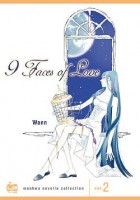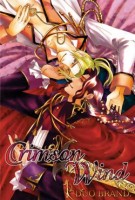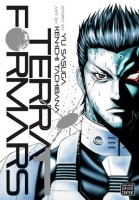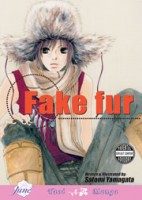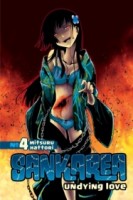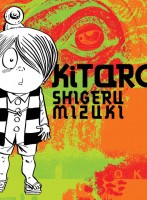My News and Reviews
Nothing except the usual My Week in Manga feature was posted last week at Experiments in Manga. I was hoping to have my random musings on Ichigo Takano’s Orange ready for November, but the month has been particularly stressful and energy-draining so at this point it looks as though December will be far more likely. Hopefully, I’ll have an in-depth feature of some sort to share soon. I also have my list of notable release from 2016 to work on, too!
There is one thing from last week that I’m very excited for–the most recent Sparkler Monthly Kickstarter! The campaign is raising funds to support the print edition of Heldrad’s highly-amusing send-up to shoujo manga Orange Junk. I greatly enjoyed the first volume of Orange Junk, which I’ve previously reviewed, but the series gets even better as it goes along. Never read any of Orange Junk? Give it a try over at Sparkler Monthly and if you like what you see please consider contributing to the Kickstarter!
Quick Takes
 Ajin: Demi-Human, Volumes 3-8 by Gamon Sakurai. For a variety of reasons, while I’ve continued to stockpile Ajin, I’ve been rather lax when it some to actually reading the manga. The eighth and latest volume in English was released relatively recently, so I figured it was probably about time that I finally got around to catching up with the series. In retrospect, I’m actually kind of glad that I had a whole stack of Ajin to read all at once. The manga generally tends to be very quickly paced so it was nice to be able to move directly from one volume to the next in succession. Ajin is best, both in art and in storytelling, when there’s action going on. Sakurai’s fight sequences are tremendously dynamic and exciting. The use of the demi-humans’ immortality and black ghosts can actually be quite clever at times, too. While the series continues to be exceptionally violent and brutal, it doesn’t seem to be as gruesome and grotesque as it once was when the demi-humans were shown to be the subjects of live experimentation. The story can be a little heavy-handed, especially when it comes to government corruption and the revelation of everyone’s tragic backstories, but the psychological elements do tend to be handled well in spite of this.
Ajin: Demi-Human, Volumes 3-8 by Gamon Sakurai. For a variety of reasons, while I’ve continued to stockpile Ajin, I’ve been rather lax when it some to actually reading the manga. The eighth and latest volume in English was released relatively recently, so I figured it was probably about time that I finally got around to catching up with the series. In retrospect, I’m actually kind of glad that I had a whole stack of Ajin to read all at once. The manga generally tends to be very quickly paced so it was nice to be able to move directly from one volume to the next in succession. Ajin is best, both in art and in storytelling, when there’s action going on. Sakurai’s fight sequences are tremendously dynamic and exciting. The use of the demi-humans’ immortality and black ghosts can actually be quite clever at times, too. While the series continues to be exceptionally violent and brutal, it doesn’t seem to be as gruesome and grotesque as it once was when the demi-humans were shown to be the subjects of live experimentation. The story can be a little heavy-handed, especially when it comes to government corruption and the revelation of everyone’s tragic backstories, but the psychological elements do tend to be handled well in spite of this.
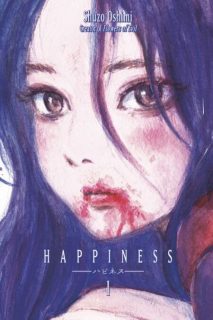 Happiness, Volume 1 by Shuzo Oshimi. I’m not especially interested in vampires and they seem to have been so overdone lately that there often has to be some sort of extra impetus for me to actually pick up a vampire manga. In the case of Happiness, the additional push that was needed came from the fact that Oshimi is also the creator of The Flowers of Evil, a manga series which left a pretty big impression on me. Oshimi is incredibly skilled at establishing the mood and atmosphere of a series. Happiness is about Okazaki, a bullied high school student who survives being attacked by a vampire only to become one himself. The pacing of Happiness is leisurely, showing only the first few days of Okazaki’s new existence as he struggles to adjust to his emerging symptoms. Given how the first volume unfolds, Okazaki’s descent into vampirism can easily be read as a metaphor for puberty and sexual awakening; it will be interesting to see if the manga continues in that direction. Happiness has an underlying sense of eroticism mixed in with its horror which, at least in my opinion, is exactly how a vampire story ought to be. There is also a fair amount of angst in the manga, something that I’ve come to expect from Oshimi’s work.
Happiness, Volume 1 by Shuzo Oshimi. I’m not especially interested in vampires and they seem to have been so overdone lately that there often has to be some sort of extra impetus for me to actually pick up a vampire manga. In the case of Happiness, the additional push that was needed came from the fact that Oshimi is also the creator of The Flowers of Evil, a manga series which left a pretty big impression on me. Oshimi is incredibly skilled at establishing the mood and atmosphere of a series. Happiness is about Okazaki, a bullied high school student who survives being attacked by a vampire only to become one himself. The pacing of Happiness is leisurely, showing only the first few days of Okazaki’s new existence as he struggles to adjust to his emerging symptoms. Given how the first volume unfolds, Okazaki’s descent into vampirism can easily be read as a metaphor for puberty and sexual awakening; it will be interesting to see if the manga continues in that direction. Happiness has an underlying sense of eroticism mixed in with its horror which, at least in my opinion, is exactly how a vampire story ought to be. There is also a fair amount of angst in the manga, something that I’ve come to expect from Oshimi’s work.
 Kitaro, Volume 2: Kitaro Meets Nurarihyon by Shigeru Mizuki. I am still absolutely thrilled that more of Mizuki’s Kitaro manga is being released in English. However, I was a little sad that the second volume of Drawn & Quarterly’s new series didn’t include the same sort of bonus activities that were present in the first. Those were fun. But then again, Kitaro Meets Nurarihyon is plenty of fun in and of itself. In addition to an opening essay and a closing set of yokai files by the series’ translator Zack Davisson, the volume collects seven of Mizuki’s short Kitaro manga, most of which are from the latter part of the 1960s although one is from the late 1970s. Generally when I think of yokai, I think of traditional Japanese folklore. However, the term can also be applied more broadly. In Kitaro, Mizuki doesn’t limit himself and incorporates mythology, urban legends, and popular culture from both within and outside of Japan. For example, in Kitaro Meets Nurarihyon, a descendant of Dracula plays a very important role in one of the stories. Sometimes the results are more cohesive than others, but I particularly enjoy and find it interesting how Mizuki is able to meld seemingly disparate elements and traditions together.
Kitaro, Volume 2: Kitaro Meets Nurarihyon by Shigeru Mizuki. I am still absolutely thrilled that more of Mizuki’s Kitaro manga is being released in English. However, I was a little sad that the second volume of Drawn & Quarterly’s new series didn’t include the same sort of bonus activities that were present in the first. Those were fun. But then again, Kitaro Meets Nurarihyon is plenty of fun in and of itself. In addition to an opening essay and a closing set of yokai files by the series’ translator Zack Davisson, the volume collects seven of Mizuki’s short Kitaro manga, most of which are from the latter part of the 1960s although one is from the late 1970s. Generally when I think of yokai, I think of traditional Japanese folklore. However, the term can also be applied more broadly. In Kitaro, Mizuki doesn’t limit himself and incorporates mythology, urban legends, and popular culture from both within and outside of Japan. For example, in Kitaro Meets Nurarihyon, a descendant of Dracula plays a very important role in one of the stories. Sometimes the results are more cohesive than others, but I particularly enjoy and find it interesting how Mizuki is able to meld seemingly disparate elements and traditions together.
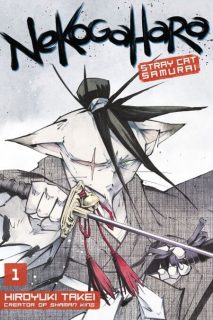 Nekogahara: Stray Cat Samurai, Volume 1 by Hiroyuki Takei. Best known as the creator of Shaman King (which I somewhat surprisingly haven’t actually read yet), one of Takei’s most recent manga series is Nekogahara. Story-wise, it’s a fairly familiar tale of a ronin wandering the country, doing good deeds while trying to outrun past tragedies. There are numerous manga, novels, anime, and film that follow a similar premise. What makes Nekogahara stand out from all of those is that all of the principal players are literally cats. Granted, they’re cats dressed in kimono, carrying swords, and so on. Humans exist in Nekogahara, too, more or less as the daimyo, though they are generally discussed rather than seen. The lead of Nekogahara is Norachiyo, a scarred tom who was once a kept cat but who is now living his life as a stray. He is an extremely capable fighter and legend has it that he once even killed a person. Both the story and the visuals of Nekogahara rely on chanbara tropes. The actual flow of movement and action can sometimes be difficult to discern, but overall the artwork and character designs are rather stylish. Nekogahara is played fairly straight, but the characters’ more cat-like behaviors do bring levity to the manga.
Nekogahara: Stray Cat Samurai, Volume 1 by Hiroyuki Takei. Best known as the creator of Shaman King (which I somewhat surprisingly haven’t actually read yet), one of Takei’s most recent manga series is Nekogahara. Story-wise, it’s a fairly familiar tale of a ronin wandering the country, doing good deeds while trying to outrun past tragedies. There are numerous manga, novels, anime, and film that follow a similar premise. What makes Nekogahara stand out from all of those is that all of the principal players are literally cats. Granted, they’re cats dressed in kimono, carrying swords, and so on. Humans exist in Nekogahara, too, more or less as the daimyo, though they are generally discussed rather than seen. The lead of Nekogahara is Norachiyo, a scarred tom who was once a kept cat but who is now living his life as a stray. He is an extremely capable fighter and legend has it that he once even killed a person. Both the story and the visuals of Nekogahara rely on chanbara tropes. The actual flow of movement and action can sometimes be difficult to discern, but overall the artwork and character designs are rather stylish. Nekogahara is played fairly straight, but the characters’ more cat-like behaviors do bring levity to the manga.
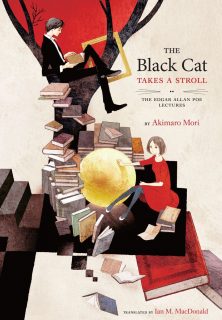 The Black Cat Takes a Stroll: The Edgar Allan Poe Lectures by Akimaro Mori. Bento Books doesn’t release very many titles, but the publisher’s books tend to be interesting so I make a point to keep an eye out for them. The Black Cat Takes a Stroll is one of Bento Books most recent releases. In addition to being the first volume in Mori’s Black Cat series, it was also the winner of Japan’s inaugural Agatha Christie Award for mystery fiction. The book collects six largely episodic but related short stories featuring the Black Cat, a young but respected professor specializing in aesthetic truth, told from the perspective of his personal assistant, a female graduate student whose research focuses on Edgar Allan Poe. I really wanted to like The Black Cat Takes a Stroll more than I actually did. I love the series’ basic concept and all of the literary and cultural references found in the stories. Sadly, the mysteries come across as trying too hard to be intellectual or overly academic and their solutions are frequently convoluted and coincidental. In addition to that, despite having a few charming and endearing quirks (such as his fondness for strawberry parfaits), the Black Cat tends to be infuriating more than anything else, misusing his intelligence in a way that is deliberately cryptic and intentionally manipulative of both the narrator and readers.
The Black Cat Takes a Stroll: The Edgar Allan Poe Lectures by Akimaro Mori. Bento Books doesn’t release very many titles, but the publisher’s books tend to be interesting so I make a point to keep an eye out for them. The Black Cat Takes a Stroll is one of Bento Books most recent releases. In addition to being the first volume in Mori’s Black Cat series, it was also the winner of Japan’s inaugural Agatha Christie Award for mystery fiction. The book collects six largely episodic but related short stories featuring the Black Cat, a young but respected professor specializing in aesthetic truth, told from the perspective of his personal assistant, a female graduate student whose research focuses on Edgar Allan Poe. I really wanted to like The Black Cat Takes a Stroll more than I actually did. I love the series’ basic concept and all of the literary and cultural references found in the stories. Sadly, the mysteries come across as trying too hard to be intellectual or overly academic and their solutions are frequently convoluted and coincidental. In addition to that, despite having a few charming and endearing quirks (such as his fondness for strawberry parfaits), the Black Cat tends to be infuriating more than anything else, misusing his intelligence in a way that is deliberately cryptic and intentionally manipulative of both the narrator and readers.



